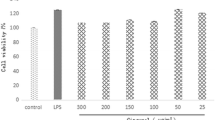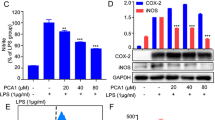Abstract
Objective
Cucurbitacin E (CuE), a triterpenoid compound isolated from Cucurbitaceae plants, possesses a wide range of biological activities including anti-inflammatory properties. The present study aimed to investigate the anti-inflammatory effect of CuE and the underlying mechanism of action.
Methods
The anti-inflammatory effect of CuE was evaluated in lipopolysaccharide (LPS)-stimulated RAW 264.7 cells. Cell proliferation was assessed using a modified MTT assay. Cell cycle distribution was analyzed by propidium iodide staining. The actin cytoskeleton was examined by immunofluorescent staining. The expression of tumor necrosis factor (TNF)-α and interleukin (IL)-1β was determined by intracellular cytokine staining. G-actin level and nuclear factor (NF)-κB nuclear translocation were detected by immunoblotting.
Results
CuE inhibited cell proliferation and induced cell cycle arrest at G2/M phase in RAW 264.7 cells. CuE also suppressed LPS-induced cell spreading and pseudopodia formation. These effects were associated with decreased G-actin level and severe actin aggregation. Moreover, CuE significantly inhibited both TNF-α and IL-1β production in LPS-stimulated RAW 264.7 cells. This was likely mediated by suppressing LPS-induced nuclear translocation of NF-κB, a critical transcription factor responsible for pro-inflammatory cytokine expression.
Conclusion
CuE displayed anti-inflammatory effects through suppression of NF-κB nuclear translocation leading to a decreased expression of TNF-α and IL-1β in LPS-stimulated RAW 264.7 cells.





Similar content being viewed by others
References
Chan KT, Li K, Liu SL, Chu KH, Toh M, Xie WD. Cucurbitacin B inhibits STAT3 and the Raf/MEK/ERK pathway in leukemia cell line K562. Cancer Lett. 2010;289:46–52.
Dong Y, Lu B, Zhang X, Zhang J, Lai L, Li D, Wu Y, Song Y, Luo J, Pang X, Yi Z, Liu M. Cucurbitacin E, a tetracyclic triterpenes compound from Chinese medicine, inhibits tumor angiogenesis through VEGFR2-mediated Jak2-STAT3 signaling pathway. Carcinogenesis. 2010;31:2097–104.
Peters RR, Farias MR, Ribeiro-do-Valle RM. Anti-inflammatory and analgesic effects of cucurbitacins from Wilbrandia ebracteata. Planta Med. 1997;63:525–8.
Duncan KL, Duncan MD, Alley MC, Sausville EA. Cucurbitacin E-induced disruption of the actin and vimentin cytoskeleton in prostate carcinoma cells. Biochem Pharmacol. 1996;52:1553–60.
Abdelwahab SI, Hassan LE, Sirat HM, Yagi SM, Koko WS, Mohan S, Taha MM, Ahmad S, Chuen CS, Narrima P, Rais MM, Hadi AH. Anti-inflammatory activities of cucurbitacin E isolated from Citrullus lanatus var. citroides: role of reactive nitrogen species and cyclooxygenase enzyme inhibition. Fitoterapia. 2011;82:1190–7.
Salminen A, Huuskonen J, Ojala J, Kauppinen A, Kaarniranta K, Suuronen T. Activation of innate immunity system during aging: NF-kB signaling is the molecular culprit of inflamm-aging. Ageing Res Rev. 2008;7:83–105.
Sen R, Baltimore D. Inducibility of K immunoglobulin enhancer-binding protein NF-κB by a posttranslational mechanism. Cell. 1986;47:921–8.
Karin M, Staudt L. NF-κB a network hub controlling immunity, inflammation, and cancer: a subject collection from Cold Spring Harbor perspectives in biology. Cold Spring Harbor, Cold Spring Harbor Laboratory Press, NY; 2010. viii, p 271.
Karin M, Greten FR. NF kappa B: linking inflammation and immunity to cancer development and progression. Nat Rev Immunol. 2005;5:749–59.
Liou H-C. NF-κB/Rel transcription factor family. Georgetown, Tex. New York: Landes Bioscience/Eurekah.com, Springer Science+Business Media, 2006. p 185.
Jin HR, Jin X, Dat NT, Lee JJ. Cucurbitacin B suppresses the transactivation activity of RelA/p65. J Cell Biochem. 2011;112:1643–50.
Zhang Y, Ouyang D, Xu L, Ji Y, Zha Q, Cai J, He X. Cucurbitacin B induces rapid depletion of the G-actin pool through reactive oxygen species-dependent actin aggregation in melanoma cells. Acta Biochim Biophys Sin. 2011;43:556–67.
Zhang YT, Ouyang DY, Xu LH, Ji YH, Zha QB, Cai JY, He XH. Cucurbitacin B induces rapid depletion of the G-actin pool through reactive oxygen species-dependent actin aggregation in melanoma cells. Acta Biochim Biophys Sin. 2011;43:556–67.
Ouyang D, Zhang Y, Xu L, Li J, Zha Q, He X. Histone deacetylase inhibitor valproic acid sensitizes B16F10 melanoma cells to cucurbitacin B treatment. Acta Biochim Biophys Sin. 2011;43:487–95.
Duncan MD, Duncan KL. Cucurbitacin E targets proliferating endothelia. J Surg Res. 1997;69:55–60.
Jayaprakasam B, Seeram NP, Nair MG. Anticancer and antiinflammatory activities of cucurbitacins from Cucurbita andreana. Cancer Lett. 2003;189:11–6.
Ziegler-Heitbrock H, Sternsdorf T, Liese J, Belohradsky B, Weber C, Wedel A, Schreck R, Bauerle P, Strobel M. Pyrrolidine dithiocarbamate inhibits NF-κB mobilization and TNF production in human monocytes. J Immunol. 1993;151:6986–93.
Varfolomeev EE, Ashkenazi A. Tumor necrosis factor: an apoptosis JuNKie? Cell. 2004;116:491–7.
Nakashima S, Matsuda H, Kurume A, Oda Y, Nakamura S, Yamashita M, Yoshikawa M. Cucurbitacin E as a new inhibitor of cofilin phosphorylation in human leukemia U937 cells. Bioorg Med Chem Lett. 2010;20:2994–7.
Sorensen PM, Iacob RE, Fritzsche M, Engen JR, Brieher WM, Charras G. Eggert US. ACS Chem Biol: The natural product cucurbitacin E inhibits depolymerization of actin filaments; 2012.
Momma K, Masuzawa Y, Nakai N, Chujo M, Murakami A, Kioka N, Kiyama Y, Akita T, Nagao M. Direct interaction of Cucurbitacin E isolated from Alsomitra macrocarpa to actin filament. Cytotechnology. 2008;56:33–9.
Huang WW, Yang JS, Lin MW, Chen PY, Chiou SM, Chueh FS, Lan YH, Pai SJ, Tsuzuki M, Ho WJ, Chung JG. Cucurbitacin E induces G(2)/M phase arrest through STAT3/p53/p21 signaling and provokes apoptosis via Fas/CD95 and mitochondria-dependent pathways in human bladder cancer T24 cells. Evid Based Complement Alternat Med. 2012;2012:952762.
Li Y, Wang R, Ma E, Deng Y, Wang X, Xiao J, Jing Y. The induction of G2/M cell-cycle arrest and apoptosis by cucurbitacin E is associated with increased phosphorylation of eIF2α in leukemia cells. Anticancer Drugs. 2010;21:389–400.
Beutler B, Cerami A. The biology of cachectin/TNF–a primary mediator of the host response. Ann Rev Immunol. 1989;7:625–55.
Verstrepen L, Bekaert T, Chau TL, Tavernier J, Chariot A, Beyaert R. TLR-4, IL-1R and TNF-R signaling to NF-κB: variations on a common theme. Cell Mol Life Sci. 2008;65:2964–78.
Yang SK, Wang YC, Chao CC, Chuang YJ, Lan CY, Chen BS. Dynamic cross-talk analysis among TNF-R, TLR-4 and IL-1R signalings in TNF-α-induced inflammatory responses. BMC Med Genomics. 2010;3:19.
Lee KC, Chang HH, Chung YH, Lee TY. Andrographolide acts as an anti-inflammatory agent in LPS-stimulated RAW264.7 macrophages by inhibiting STAT3-mediated suppression of the NF-kappaB pathway. J Ethnopharmacol. 2011;135:678–84.
O’Neill LAJ, Kaltschmidt C. NF-kB: a crucial transcription factor for glial and neuronal cell function. Trends Neurosci. 1997;20:252–8.
Shrum CK, Defrancisco D, Meffert MK. Stimulated nuclear translocation of NF-κB and shuttling differentially depend on dynein and the dynactin complex. Proc Natl Acad Sci USA. 2009;106:2647–52.
Rosette C, Karin M. Cytoskeletal control of gene expression: depolymerization of microtubules activates NF-kappa B. J Cell Biol. 1995;128:1111–9.
Banan A, Keshavarzian A, Zhang L, Shaikh M, Forsyth C, Tang Y, Fields J. NF-κB activation as a key mechanism in ethanol-induced disruption of the F-actin cytoskeleton and monolayer barrier integrity in intestinal epithelium. Alcohol. 2007;41:447–60.
Acknowledgments
This work is supported by grants from the National Natural Science Foundation of China (No.81173604), the Specialized Research Program of “Twelfth Five-Year Plan” of China (No.2011ZX09307-303-03), and the Fundamental Research Funds for the Central Universities (No.21612411).
Author information
Authors and Affiliations
Corresponding author
Additional information
Responsible Editor: Liwu Li.
Rights and permissions
About this article
Cite this article
Qiao, J., Xu, Lh., He, J. et al. Cucurbitacin E exhibits anti-inflammatory effect in RAW 264.7 cells via suppression of NF-κB nuclear translocation. Inflamm. Res. 62, 461–469 (2013). https://doi.org/10.1007/s00011-013-0598-z
Received:
Revised:
Accepted:
Published:
Issue Date:
DOI: https://doi.org/10.1007/s00011-013-0598-z




